As of lately, LinkedIn has been the place to be for marketers, brand evangelists, and founders alike. Although it has always been known as “the” professional social networking site, LinkedIn has recently experienced an uptick in engagement.
Furthermore, over the past year, the number of LinkedIn users has increased significantly, now standing at over 500 million users.
What’s interesting is that LinkedIn is not dominated solely by influencers and celebrities. Even seemingly “normal” people have thousands of followers and receive high engagement rates. This hints to the fact that there is a lot of opportunity for just about any user, as long as they develop an effective strategy.
If you’re interested in growing your LinkedIn profile by increasing the engagement on your activity, below are five actionable tips that can help you step up your content game. This will help you create content that encourages engagement and will lead to more connections, followers, and potentially leads for your business.
Keep in mind: the focus remains on people, just as it always has. We’re social marketers and to truly take our growth to the next level we have to scale both our content production and our relationships.
Let’s jump right in…
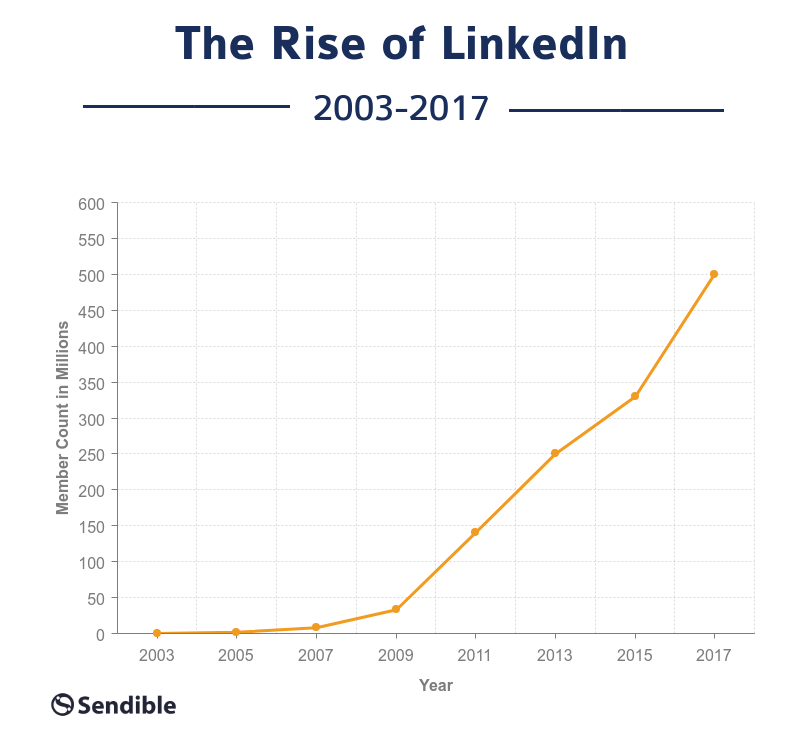
Leveraging the new LinkedIn
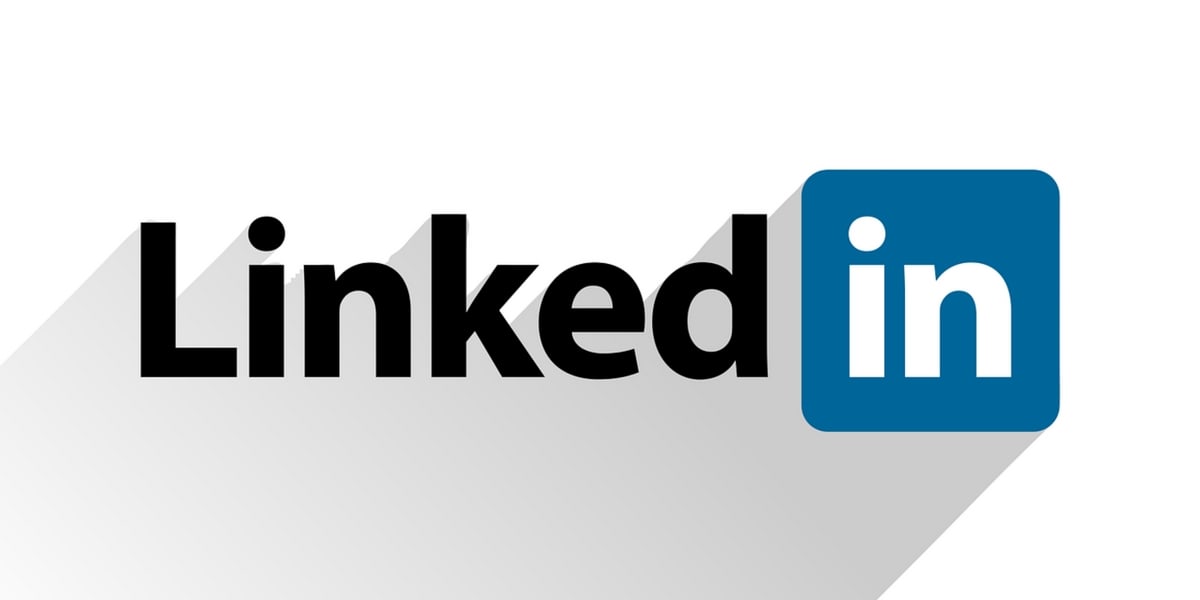
1.) Identify your audiences
You may not have many connections on LinkedIn at the moment, and that’s okay. Heck, even CEOs only have an average of 930 connections on the platform.
What we’re trying to do here is develop a better idea of the people we want to connect and speak with. It’s similar to developing personas for your website. However, the audiences and type of content that we create on LinkedIn will be different than what’s on your blog.
Typically, we can break it down into three audience types:
- General Professionals
- Professionals in Your Industry/Position
- Potential Customers
General Professionals
The content that typically goes viral on LinkedIn is usually targeted at a very general audience. It strikes a common vein in people, and since it resonates with such a large group, the engagement on the content goes through the roof.
No matter which industry you’re in, this type of content should at least be a small part of your strategy. It’s relatively easy to create and often includes short stories, lessons, and general career tips.
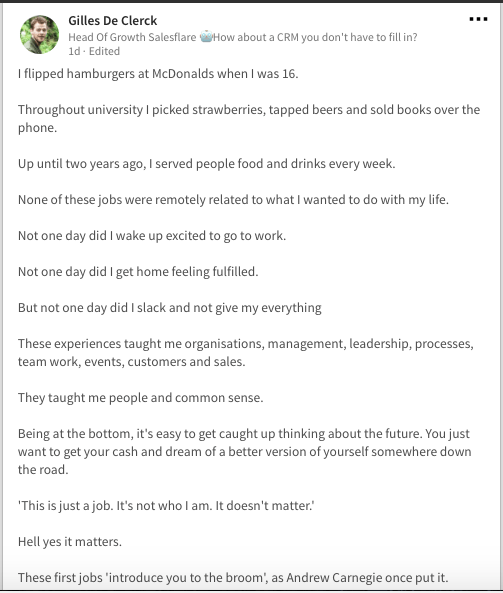
Professionals in Your Industry/Position
Professionals in both your industry and those in your position will be naturally drawn to your content. After all, the topics that you discuss should be extremely similar in nature. You experience the same problems at work and potentially, similar aspirations for career movement.
When you’re searching for solutions or trying to solve a particular problem, industry professionals will be able to help you and vice versa. This is where your opportunity arises.
Although these folks might not be purchasing your product, it’s important to have them in your network.
If you create content that is above and beyond, you'll be awarded with engagement, which will lead to more connections and leads.
In a sense, keeping this segment of your audience engaged has an indirect benefit in the long run. Whereas potential customers may seek out a problem you solve only once, the content you offer to those in this segment has continuous relevance.
Quentin Ford offers an excellent example. He constantly provides tips and updates that are helpful for other Facebook marketers. This helps to establish himself as a leader in this respective category.
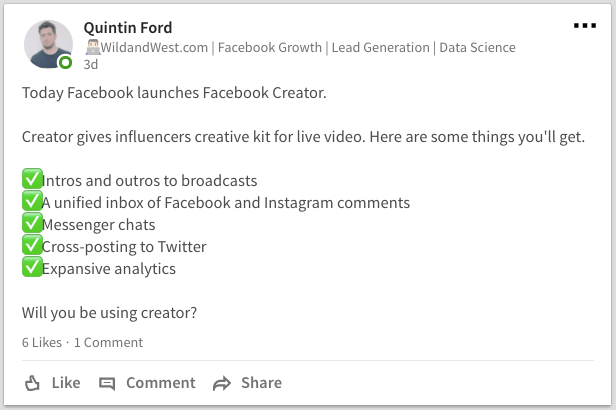
Potential Customers
The best way to attract potential customers is by doing great work before you work with them.
If you can create awesome content that subtly aligns with your product offering, you’ll be able to attract leads in the long term. Similar to how I mentioned above, customers are looking for a solution, oftentimes a one-time solution.
Therefore, they may not necessarily be paying attention to you as often as same-industry or same-position LinkedIn users might, but when they’re seeking out a solution within your niche, you'll be the first person they look to.
Especially in B2B, this is extremely valuable. In fact, according to one study by HubSpot, LinkedIn is 277% more effective for lead generation than Facebook and Twitter. This means that the distribution of relevant content for your offering is an excellent long-term strategy.
Try your best to own that space within your network. And also, don’t be afraid to offer help both on and off LinkedIn. For example, John Barrows shares something that can directly help his prospective customers. It’s the perfect combination of a value proposition that aligns with his service offering.
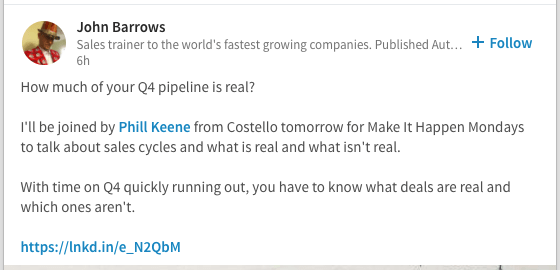
2.) Tell stories and be human

This relates directly to the general audience described above while diving one level deeper. What better way to connect with other humans than telling stories? Both of achievement and failure. By exposing ourselves, opening up to our audience, and telling stories about our experiences, we can naturally build trust and grow a following.
It’s amazing that some individuals have built a large following from nothing by simply documenting their story on LinkedIn. And the beauty of what they have done is that both the good and bad is shown.
People seem to empathize with the stories of failure, and are inspired by their triumphs.
Much of the argument against this behavior extends from the belief that LinkedIn is a professional network and people should share content that is strictly business-related.
However, this is short-sighted. People want to connect and engage with other humans on topics that are inherently human. We can all relate to stories, this is why they work so well on a platform that has been dominated by recruiters and people sharing business-related content.
Don’t be afraid to intertwine stories into your content strategy on LinkedIn, your connections will reward you for it.
Josh Fechter is the king of telling dramatic stories. He shares the good and the bad in his efforts to launch a successful business.
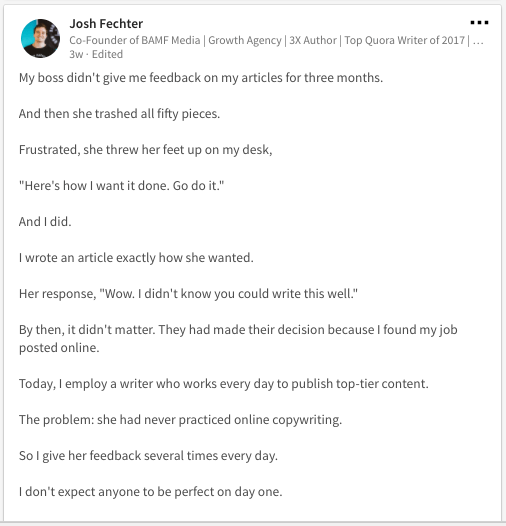
3.) Focus on features that work
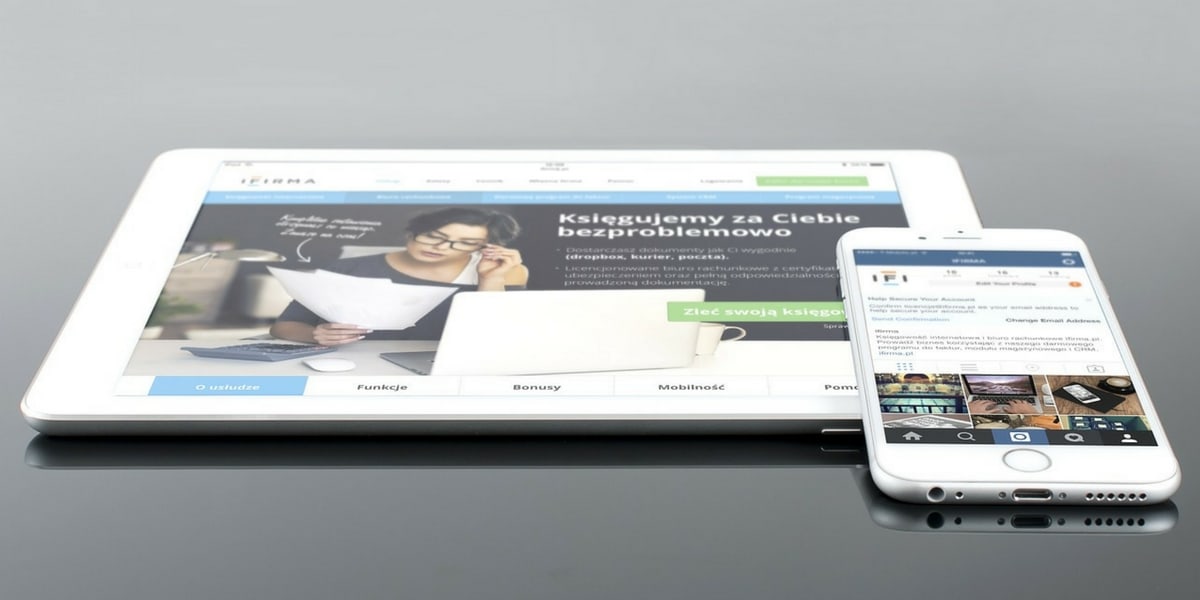
There are a lot of options for content creators on LinkedIn.
You can share updates in full text (up to 1300 characters), post videos that are both native or from YouTube, as well as share pictures and write complete articles on Pulse.
I’ve seen many people who excel at LinkedIn successfully integrate all sorts of features within their updates. It keeps followers interested and engaged. Plus, depending on the nature of the content, it may be best suited for a particular format.
For example, Allen Gannett shares interviews in video format with well-known industry professionals:
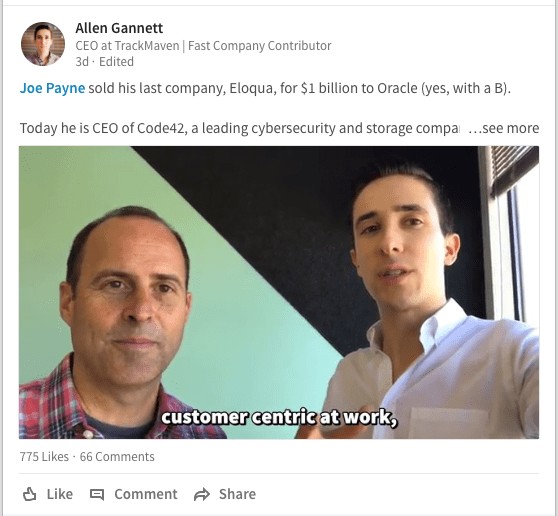
As LinkedIn evolves, it’s even stealing some well-known features from other social platforms. For example, the LinkedIn product team recently introduced geofilters for events and conferences.
This gives companies the ability to promote their event via users’ videos on LinkedIn. Attendees can simply record a video, add the filter, and post to their LinkedIn feed.
It's an excellent recipe: LinkedIn has effectively matched business-related content with social features that have already proven to be in-demand.
Frankly, this seems to feed into LinkedIn’s push for more “human” content. Not only does this allow people to be more creative and authentic as they create and share, but it also allows them to actively monitor their content performance via analytics.
For example, LinkedIn provides information not only on how many people viewed and engaged with your updates but, more importantly, what type of people decided to engage with it.
The reason this is useful is that you can see if your content strategy is effective. If you’re hoping to reach people in sales or employees from a certain company, you are no longer blind about your content's effectiveness in doing just that.
Are you attracting the right audience? LinkedIn will tell you.
A word to the wise: Try your best to avoid links within posts. I’ve done a good deal of research combing through LinkedIn updates and I’ve noticed that LinkedIn tends to punish posts that include links.
After analyzing 400 posts, there were some interesting themes. Below you can see the effect of certain features on post performance.
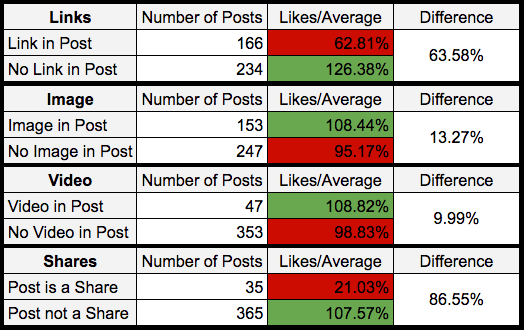
As you can see, links have a negative effect on performance, whereas images and videos tend to increase the number of likes that an update will receive.
To avoid having posts that get low engagement and less distribution in your network, try putting your links in the comments rather than the body of the post itself. Just be sure to let your connections know.
4.) Make connections and engage

People want to be following people, not robots. The point I’m trying to get across is that consistency is important on social media, but not when you’re consistent in simply posting alone.
As much as you do want to be sharing content on a regular basis, engaging with others will ultimately help drive engagement on your overall activity..
Helping people when it serves you no good is the best way to earn trust. It’s a long-term game, but it will pay off.
Furthermore, be mindful of connection opportunities. Luckily, LinkedIn is chock full of accurate and up-to-date information on its members. You can selectively choose people to reach out to and connect with, either by searching based on the company they work at, what skills they have, or their job function. Have a look at the best LinkedIn profiles and update yours to improve your chances to be noticed and accepted!.
To take it one step further, you can leverage pooled groups of ideal connections by joining groups and actively sharing and engaging with content. You’ll have access to people that care about similar topics, giving you an excellent starting point for conversation.
One last tip is to focus on going beyond the like button. It’s easy to make a quick tap on your smartphone, but it’s more valuable to make a comment that stimulates conversation, even if it's more difficult.
This is reflected in the algorithm. Basically, a comment is “worth more” than a like. Gretta van Riel breaks down how it works.
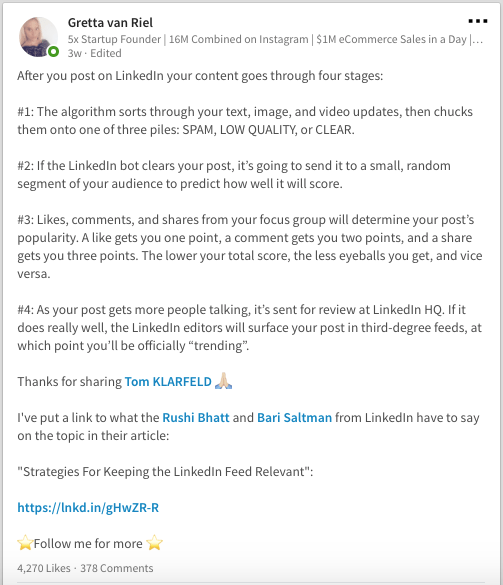
The like button is the easiest way to engage with a post, and because of this, it’s also the least valuable in feeding the algorithm. If you want to drive more engagement on your own posts, you have to be willing to do so on others’ content.
5.) Create, promote, and collaborate with others

This takes things one step farther than my point in tip #4.
Instead of simply chatting, commenting, and engaging on LinkedIn:: create, promote, and collaborate with others.
It’s amazing when you have the power of a few audiences, rather than just yours alone. The reason for this is that growth happens when your content reaches into your second and third degree network. This gives people outside your immediate network the opportunity to see your updates and connect with you.
In a sense, you could think of it as referrals: When you create content with other individuals, they’ll be promoting your co-created content (excerpts from articles, video interviews, how you helped each other, etc.).
When they promote your content by liking, commenting, or tagging you in their own content, they’re indirectly referring their audience to you.
In a sense, creating with others helps bridge the gap between you and a new audience. The best part of this, is that there is a synergistic effect in regards to the number of impressions when you’re working with several people.
Take a look at the number of people that will be “referred” to you by your collaborators:
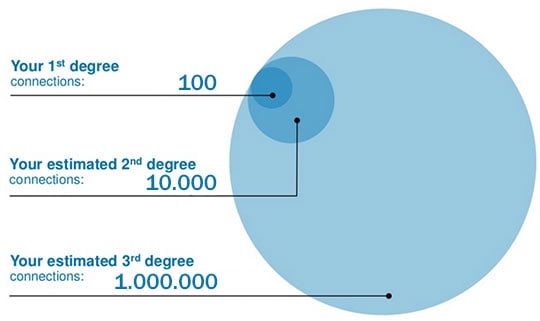
For example, there was recently a campaign on LinkedIn called #LetsGetHonest which encouraged people to open up and share stories about mistakes, failure, problems, and so forth.
It was started by several people who successfully promoted it together. They first shared their own stories, and then encouraged others to share as well.
It ended up as a trending movement on the platform. Even LinkedIn's CEO, Jeff Weiner commented on it, thanking them for starting it.
At the forefront, this helped to start something people were very passionate about, and gave members the courage to share their own story. As an extension, the founders of the movement gained exposure for themselves, as they were often mentioned in the posts from the community.
Don’t be afraid to get creative, reach out for collaborations, and actively share what others are doing. It’s the easiest way to get on someone’s good side and develop longer-lasting relationships.
Your turn
If you’re just getting started on LinkedIn, you’re right in time. There’s a lot of opportunity for growth on the platform and it doesn’t appear to be stopping as we move into 2018.
Remember that your strategy will be a construct of many components, such as the audiences you speak to, the niche you’re in, and your personality. However, no matter what your strategy is specifically, it will still be bound in a framework of genuine engagement and value proposition.
In the long term, this is the best overall approach to take, especially with the results we’ve seen on LinkedIn over the past few months.
Best of luck!



